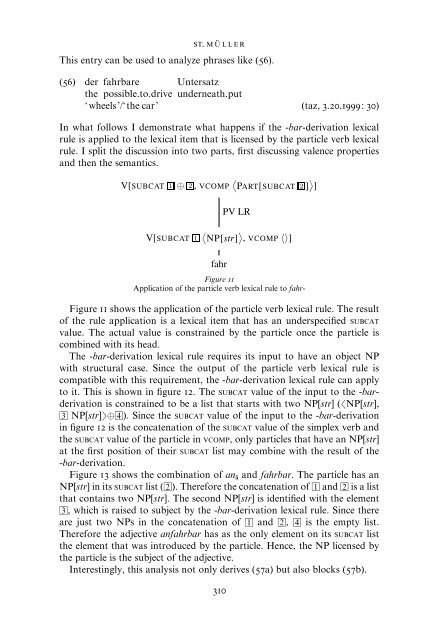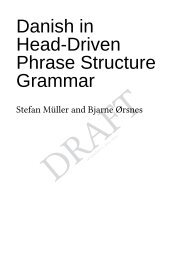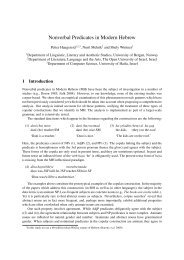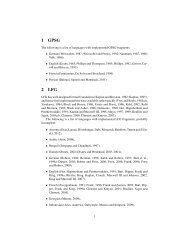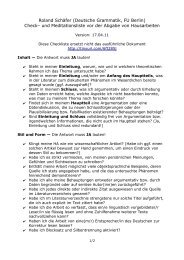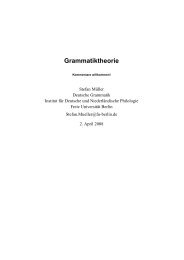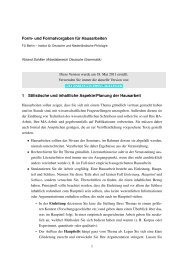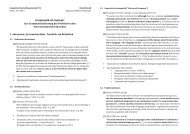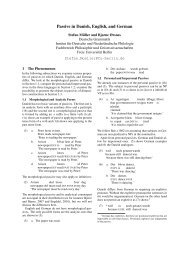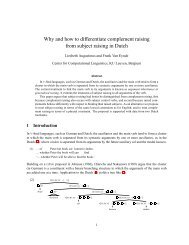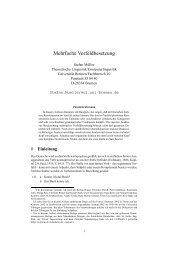Solving the bracketing paradox - German Grammar Group FU Berlin
Solving the bracketing paradox - German Grammar Group FU Berlin
Solving the bracketing paradox - German Grammar Group FU Berlin
Create successful ePaper yourself
Turn your PDF publications into a flip-book with our unique Google optimized e-Paper software.
ST. MÜLLER<br />
This entry can be used to analyze phrases like (56).<br />
(56) der fahrbare Untersatz<br />
<strong>the</strong> possible.to.drive underneath.put<br />
‘wheels’/‘<strong>the</strong> car’ (taz, 3.20.1999: 30)<br />
In what follows I demonstrate what happens if <strong>the</strong> -bar-derivation lexical<br />
rule is applied to <strong>the</strong> lexical item that is licensed by <strong>the</strong> particle verb lexical<br />
rule. I split <strong>the</strong> discussion into two parts, first discussing valence properties<br />
and <strong>the</strong>n <strong>the</strong> semantics.<br />
〈 〉<br />
V[SUBCAT 1 ⊕ 2 , VCOMP PART[SUBCAT 2 ] ]<br />
PV LR<br />
V[SUBCAT 1<br />
〈<br />
NP[str]<br />
〉<br />
, VCOMP 〈〉]<br />
fahr<br />
Figure 11<br />
Application of <strong>the</strong> particle verb lexical rule to fahr-<br />
Figure 11 shows <strong>the</strong> application of <strong>the</strong> particle verb lexical rule. The result<br />
of <strong>the</strong> rule application is a lexical item that has an underspecified SUBCAT<br />
value. The actual value is constrained by <strong>the</strong> particle once <strong>the</strong> particle is<br />
combined with its head.<br />
The -bar-derivation lexical rule requires its input to have an object NP<br />
with structural case. Since <strong>the</strong> output of <strong>the</strong> particle verb lexical rule is<br />
compatible with this requirement, <strong>the</strong> -bar-derivation lexical rule can apply<br />
to it. This is shown in figure 12. The SUBCAT value of <strong>the</strong> input to <strong>the</strong> -barderivation<br />
is constrained to be a list that starts with two NP[str] (nNP[str],<br />
3 NP[str]m4). Since <strong>the</strong> SUBCAT value of <strong>the</strong> input to <strong>the</strong> -bar-derivation<br />
in figure 12 is <strong>the</strong> concatenation of <strong>the</strong> SUBCAT value of <strong>the</strong> simplex verb and<br />
<strong>the</strong> SUBCAT value of <strong>the</strong> particle in VCOMP, only particles that have an NP[str]<br />
at <strong>the</strong> first position of <strong>the</strong>ir SUBCAT list may combine with <strong>the</strong> result of <strong>the</strong><br />
-bar-derivation.<br />
Figure 13 shows <strong>the</strong> combination of an 5 and fahrbar. The particle has an<br />
NP[str]initsSUBCAT list (2). Therefore <strong>the</strong> concatenation of 1 and 2 is a list<br />
that contains two NP[str]. The second NP[str] is identified with <strong>the</strong> element<br />
3, which is raised to subject by <strong>the</strong> -bar-derivation lexical rule. Since <strong>the</strong>re<br />
are just two NPs in <strong>the</strong> concatenation of 1 and 2, 4 is <strong>the</strong> empty list.<br />
Therefore <strong>the</strong> adjective anfahrbar has as <strong>the</strong> only element on its SUBCAT list<br />
<strong>the</strong> element that was introduced by <strong>the</strong> particle. Hence, <strong>the</strong> NP licensed by<br />
<strong>the</strong> particle is <strong>the</strong> subject of <strong>the</strong> adjective.<br />
Interestingly, this analysis not only derives (57a) but also blocks (57b).<br />
310


